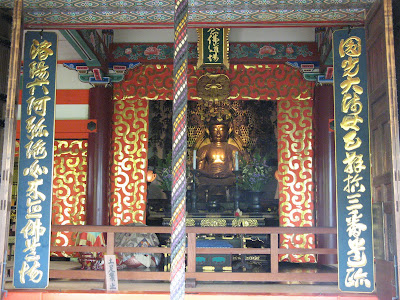Kyoto is a must-see city for anyone visiting Japan. First settled in 7th century, by 794 Kyoto was Japan's capital. There are over 2,000 shrines and temples in Kyoto, the geisha tradition is still alive and you only need to turn a corner within the concrete jungle to find a tranquil garden or pathway into the mountains.


 Above: Views of Kiyomizu-Dera temple
Above: Views of Kiyomizu-Dera temple
For 5 hours we walked the back streets of Kyoto and learnt about traditional crafts, including pottery and fan making, Shinto and Buddhist religion, visiting many Buddhist Temples and Shinto Shrines along the way, we visited geisha areas, stopped for tea and rice cakes and felt thoroughly educated and exhausted at the end of a great tour.


Constructed in 1397 as a retirement villa for Shogun Ashikaga Yoshimitsu, his son converted this into a temple on his death. In 1950 a young monk consummated his obsession with the temple by burning it to the ground. It was reconstructed in 1955 following the original design. I enjoyed a traditional Japanese tea in the garden of the Golden Temple. Although Adam is not keen on green tea, we concluded it may help digest the kilo of octopus he consumed earlier that day.
 Above: A row of Tanukis at train station. Tanuki is the Japanese word for raccoon dog. They have been part of Japanese folklore since ancient times. The legendary Tanuki is reputed to be mischievous and jolly, a master of disguise. You find him outside temples and restaurants, often holding a bottle of sake, a promissory note (he never pays) and he is normally sporting a whopping pair of testicles.
Above: A row of Tanukis at train station. Tanuki is the Japanese word for raccoon dog. They have been part of Japanese folklore since ancient times. The legendary Tanuki is reputed to be mischievous and jolly, a master of disguise. You find him outside temples and restaurants, often holding a bottle of sake, a promissory note (he never pays) and he is normally sporting a whopping pair of testicles.
Above: Bamboo forest walk and train ride back along Hozu-Gawa Gorge.



 Above: Japanese white-water rafting along the Hozu-Gawa, through Kyoto's western mountains. Adam enjoyed a rubbery snack at the end of our trip.
Above: Japanese white-water rafting along the Hozu-Gawa, through Kyoto's western mountains. Adam enjoyed a rubbery snack at the end of our trip. 

 Above: Hanami-koji in Gion district of Kyoto, home to historic tea houses and theatres where geishas entertain gentlemen of considerable means. Patrons can pay $3000 to spend an evening in the company of two or three geisha. Entertainment includes an exquisite meal, where very strict rules of etiquette are obeyed. Shamisen (3 stringed instrument), fan dancing and singing performances are given. There are only 100 geisha remaining in Kyoto and 80 Maiko (trainee geishas - see top photo). We are assured that geisha are not prostitutes.
Above: Hanami-koji in Gion district of Kyoto, home to historic tea houses and theatres where geishas entertain gentlemen of considerable means. Patrons can pay $3000 to spend an evening in the company of two or three geisha. Entertainment includes an exquisite meal, where very strict rules of etiquette are obeyed. Shamisen (3 stringed instrument), fan dancing and singing performances are given. There are only 100 geisha remaining in Kyoto and 80 Maiko (trainee geishas - see top photo). We are assured that geisha are not prostitutes.We were lucky enough to catch a glimpse of a few of these truly elegant ladies and they hurried to their evening appointments.
 Above: Impressive gates at Buddhist Temple, Nanzen-ji, retirement villa of Emperor Kameyama, became Zen Temple on his death in 1291. Now headquarters of Rinzai School of Zen.
Above: Impressive gates at Buddhist Temple, Nanzen-ji, retirement villa of Emperor Kameyama, became Zen Temple on his death in 1291. Now headquarters of Rinzai School of Zen. 






No comments:
Post a Comment